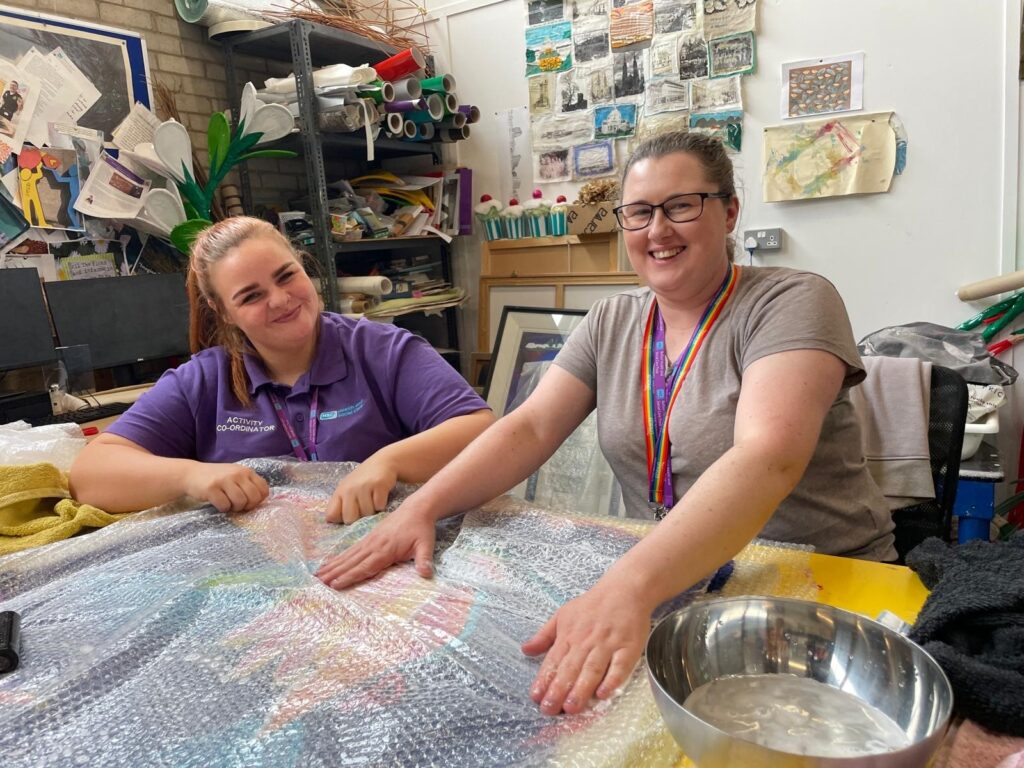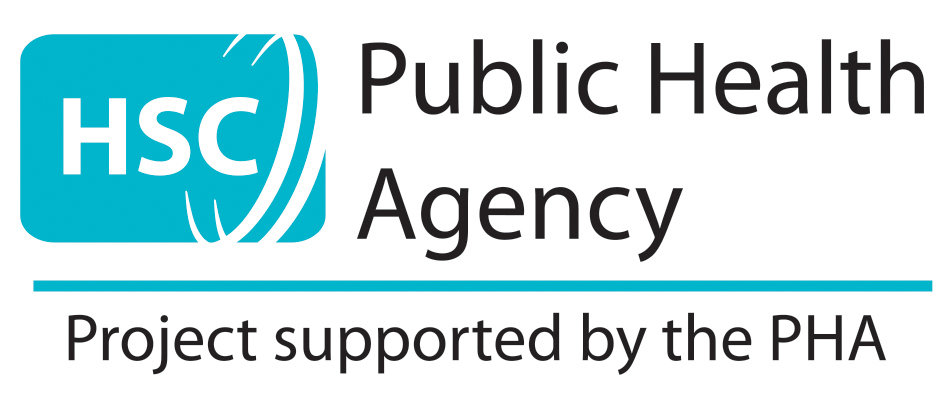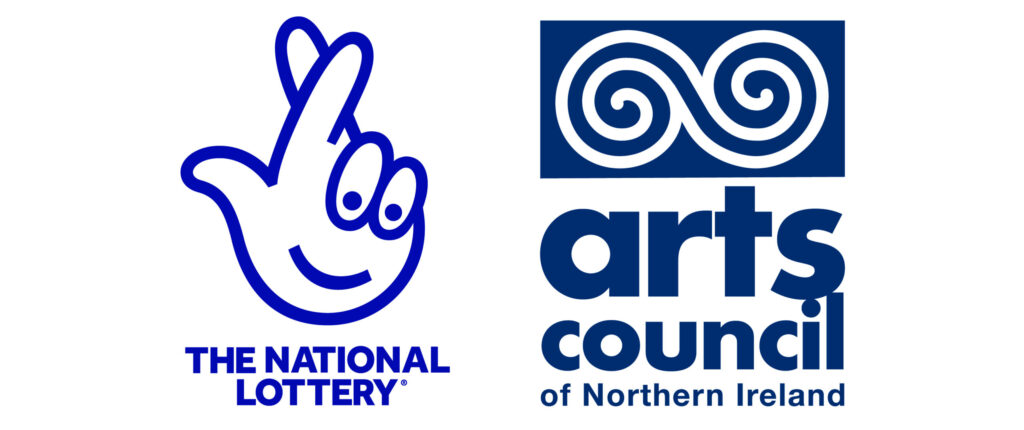Healing Through Art: A Journey of Transformation
Tammy Ellison, Activity Coordinator at Musgrave Park Hospital’s Regional Acquired Brain Injury Unit, shares how Arts Care artist Grainne Kielty has brought profound change to patients’ lives. Through creative sessions centred around the symbolism of the kingfisher, Grainne’s art-making workshops have helped patients of all ages connect, heal, and find new meaning on their rehabilitation journey.
Depending on who you speak to, the kingfisher can be considered to symbolise many human emotions and situations – everything from tranquillity and harmony, to conquering fears, transformation and embracing the unknown.
The Symbolism of the Kingfisher
But for one group of patients in Musgrave Park Hospital, the kingfisher has come to represent all these things and much more, as together they created their own kingfisher under the guidance of Arts Care artist Grainne Kielty.
Creating a Shared Vision
The group met together for around 10 weeks. All patients in the Regional Acquired Brain Injury Unit, the participants have experienced a range of health issues that have led them to require rehabilitation from a brain injury.
The group includes people of all ages, from a wide range of backgrounds, and with a variety of abilities. However, with the support of staff and Grainne, everyone worked together to create a felted artwork – a wall hanging which will be displayed in the hospital for patients, staff and visitors to enjoy.
Art-Making as a Path to Rehabilitation
The process required participants to select an image and colour palette, create large felt sheets, cut them to form the elements of the design, and then bring them together to make the final piece.
Along the way there were choices and decisions to be made collectively, and large and fine motor skills to be developed and practised as the fabric was created and then pieced. So there are some fairly clear markers for success there.
It is easy to gather information about participation, decision making, collaboration and group work, and even easier to look at the physical engagement of our art-makers, seeing who rolled up their sleeves and rolled the fabric, who cut and stitched pieces, and so on. And all of these are wonderful indications of how successful a project has been, and the value of the making.
However, as I visited the group, who have now moved on to their next art-making enterprise, I began to realise that the story of this project’s success goes much further than the simple art-work production.
The Role of Community and Support
I spoke with activity co-ordinator Tammy Ellison, and she explained: “Firstly there is the banter. It can be hard to get a group together in here, but when Grainne is in, there is always a group.
People want to join in. Even if at first they think they don’t like art, after a week or two, when they’ve heard about Grainne’s sessions, you find they decide to give it a try, and then they are there every week! The fun is so important, and the chat. We all need it!
“The sessions are always really inclusive. Physically she will make sure everyone is able to take part and will adjust the activities to make sure their abilities are matched with the processes.
No one is ever left out when Grainne is about. So everyone joins in, and patients who wouldn’t normally come together, maybe people in their 20s and people in their 70s, they can join in – all ages, all abilities.”
A Lifeline for Long-Term Rehabilitation
As we talk on, Tammy explains to me that as a rehabilitation unit, people tend to come to them for a long period of time for treatment. Often they have experienced a serious health event which has been life-altering, and the shock of their situation can be quite challenging to deal with.
For this reason, having a long-term relationship with Grainne has been a lifeline for the unit – staff and patients alike.
Grainne says: “Because I am in the unit week in, week out, we can take our time over projects and work on them slowly as ideas develop. And we can be quite flexible as patents come and go and the interests and skills in the group change. We can be quite dynamic in that way – we’re not tied to specific projects and short time frames.”
Consistency and Reassurance
It strikes me that the benefit of having Grainne there, every week, must be a very reassuring offer for patients too – Tammy agrees. “If you don’t feel like joining in at first that is ok. Because Grainne will be there next week, and the next week, and when you feel like taking part you will be made so welcome. People need to move at their own pace.
“It is also really brilliant for the staff having Grainne lead activities. Firstly, Grainne’s talent is art – she knows what she is talking about and can help people learn how to do things right. So much better than me trying to show people how to do things!
“But also, when it comes to managing group dynamics, having Grainne here is a lifeline. Many of our patients require one-to-one support, and if I am leading a session and someone needs me to accompany them back to their room, I have to get up and leave the rest of the group, and that just isn’t ok – from a safety point of view, and from an activity point of view!
But with Grainne here, I can be focussed on patient needs, and she can lead the activity and it just works. And then of course there is the variety – people see me day in, day out and I am boring. So it is brilliant when Grainne comes in, as they get to see a new face! When you are going about your everyday life, you see so many people and you can to a certain extent choose who you see. But in here you are so limited, so it is great to have people come in that they can choose to talk to and work with if they like.”
Building a Sense of Belonging
Throughout my visit, I am struck by the community feel on the unit – everyone knows everyone’s names, there are smiles and hellos and chat all along the corridors, and lots of laughter. It is apparent that this sense of community, friendliness and welcome is another very important element of life here.
A Journey of Transformation and Connection
Tammy says: “When people arrive, we want them to know that we are all here to help, and we want the very best for everyone – patients and staff alike.
“The personality of our unit is very positive. We do have a lot to do here – there are a lot of therapies, and we are very involved with the patients. So, no one is ever forced to take part in an activity – we just offer opportunities like working with Grainne and allow people to take part if they choose. And people do choose to!
“For example, John who was here today. He didn’t want to come at the start, but once he’d been, now he comes back every week!
“We have another patient who speaks very little English. When she first arrived in the unit she would come to sessions with Grainne and would only be able to stay for a few minutes really, before she got quite agitated. Now she comes to every session and loves it.”
This particular patient was in the session I attended when I visited the unit and saw her enjoyment for myself. While still not having much English, she joined in the laughter and the chat a little, made her opinions know, and happily pointed out artworks and materials to her visitor who arrived at the end of the session.
The transformation from the patient described at the start of her stay on the unit was incredible, and a testament to the great support she has received from the whole team.
It should be said that some of Grainne’s sessions for this project were able to take place in her on-site art studio, and this was perhaps the element of the project that almost struck me the most clearly.
The potential to leave the ward and travel to a non-clinical space – an airy spot filled with colour and texture and interest, where the purpose is artmaking alone, is a powerful adventure in a routine which can feel limited, daunting and full of challenge. Physically moving to place of potential and creation, with new air and new purpose is a tonic in itself.
Working in this space, under the careful guidance of a talented artist and skilled facilitator, supported by your clinical team, alongside a group of people who understand your circumstances better than most, and between you all creating an artwork full of colour and life – what an opportunity. And remember what we already learned – that the kingfisher symbolises emotions from tranquillity and harmony, to conquering fears, transformation and embracing the unknown? So it does. Bravo RABIU and Grainne, and your beautiful, brave, transformative art.
Case Study by Ali Fell on behalf of Arts Care






